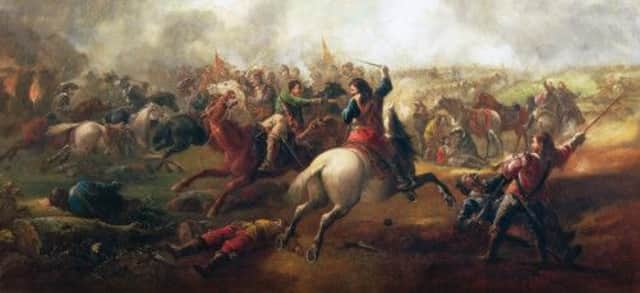How Scots ‘Taleban’ and crack forces won Civil War


According to a new book, victory for the Roundheads, as the Parliamentary forces were known, was secured by battle-hardened Scottish troops who were more comfortable slaughtering Englishmen than southern soldiers forced to fight their fellow countrymen.
A key battle at Marston Moor in 1644, which turned the tide of the 17th-century conflict between the Roundheads and the Cavaliers – King Charles I’s royalist forces – over who controls Parliament, was won by Colonel Hugh Fraser, a Scots soldier from Inverness, rather than Cromwell, who was wounded and forced off the battlefield.
Advertisement
Hide AdAdvertisement
Hide AdThe controversial new study of the bloody military campaign – in which 80,000 people died – also compares the Scottish Army of the Covenant, battalions supported by the Kirk who wished to protect Presbyterianism against the religious policies of Charles I, with the Taleban of modern day Afghanistan.
In the place of contemporary Afghan mullahs were Scots “bloody preachers” who urged their troops to slaughter innocent women and children.
The new book, How The Scots Won The English Civil War, by Alisdair McRae, points out that the Scottish force of 21,000 men was significantly larger than any other army fielded during the campaign and that many of its soldiers were veterans of European wars and prodigious fighters.
At the heart of Scotland’s efforts on the side of the Roundheads however was the Regiment of Dragoons, made up of four companies who had all experienced combat in Europe, led by Fraser, a landowner who served for four years in the Swedish army.
McRae, who has spent 30 years researching the book, explained: “The English Civil War was won by decisive campaigns in the north of England and the entry into the war and participation of the Scottish Army of the Covenant was such a decisive factor within those campaigns.”
He also points out that Scots soldiers were more combative and were: “well schooled and versed in the latest technologies of warfare, experienced and battle hardened, and perhaps capable of fighting with more fire in their bellies than their counterparts south of the Border; those English, who, however committed to their cause were still, at the end of the day, Englishmen, somewhat reluctantly fighting fellow Englishman.”
The new book states that the key battle of Marston Moor in Yorkshire, which turned the tide of the war in favour of Cromwell’s army was effectively won by both Scots troops holding the line against Royalist forces and the critical intervention of Fraser’s dragoons, which he had equipped at his own expense with 2,000 muskets and pikes. While Cromwell is frequently given credit for the victory, he had been forced to retire from the battlefield. “Cromwell later asserted: ‘we drove all before us’ and ‘they were as stubble to our swords’,” said McRae, “but there were reports that he sustained a small injury to his neck and left the battle.”
The English Civil War, was, in effect, a series of campaigns, and lasted from 1642 to 1651, dividing Scotland as well as England. A number of Scottish landowners pledged their support for the Royalists and Charles I and so raised armies against Cromwell. However, the Scottish Parliament set up the Scottish Army of the Covenant – which fought for the Parliamentarians – with a mission to fight for their religious freedom.
Advertisement
Hide AdAdvertisement
Hide AdThe author explains that the Scots preachers who accompanied the troops exhorted them to commit what today would be regarded as atrocities. In the book, McRae writes: “Bearing in mind that history is a place where the imposition of present-day values can blind you to what the place may have been like, rather reluctantly, I would suggest as a current comparison Afghan fighters, fighting sometimes with a spiritual fervour, frequently driven on by their clerics’ or mullahs’ fanatical religious urgings to acts of almost foolhardy bravery or of unforgivable horror; all this intolerance spewed out under the guise of being done in the name of God.
“Similarly, by a fanatical, powerful and influential body of clerics and ministers accompanying the Army of the Covenant, committed to engaging in its religious instruction and supervision, the soldiers of Scotland were also ‘Soldiers of God’ in the eyes of the Kirk, doing God’s bidding, even to the extent of committing what was clearly considered even by the customs of the time and doubtless by some, at least, of the soldiery, inhuman atrocities.”
Historian Michael Fry, author of The Scottish Empire, agreed with the author’s argument about Scotland’s contribution toward victory.
“It seems to me McRae’s book is a valuable contribution to the idea that the civil wars really were the Wars of Three Kingdoms, and not just an English Civil War as has been assumed, at least in England, up to now.
“It is probably true that at the outbreak of the civil wars Scotland had more experienced soldiers than England had. This was because Scots, always spoiling for a fight, had gone in their thousands to fight as mercenaries in the biggest conflict then available, the Thirty Year War in Germany.”
Twitter: @sgmcginty